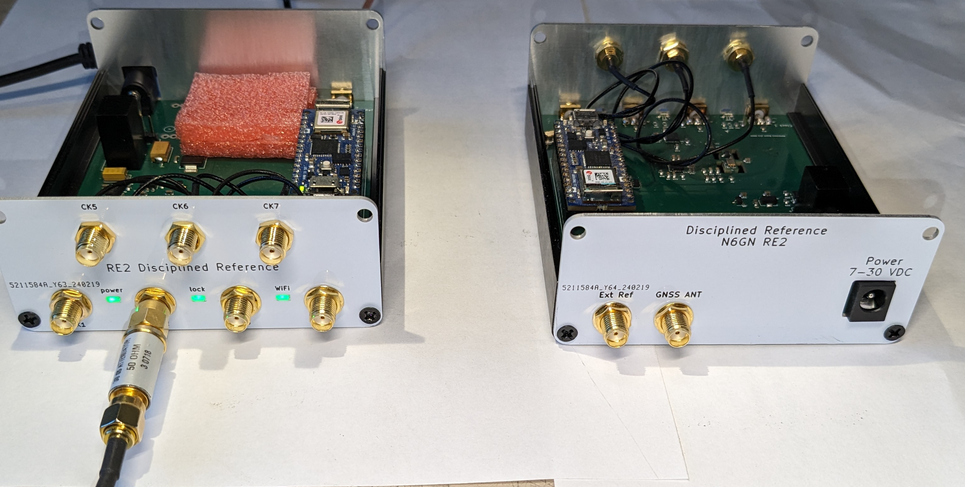RE2 - v2 GPSDO & 10 MHz Disciplined Frequency Reference

For better quick
viewing of the design, download the Source file from
the Material List below , unzip it and drop the .sch or
.pcb file onto kicanvas
from
a web browser.
Features & Improvements
- Provides up to 7 configurable user outputs, master clock for HF transceiver or SDR
- Implements Continuous Fractions algorithm for essentially perfect frequency accuracy
- Much improved close-to-carrier noise floor
- GNSS satellite or local 10 MHz frequency reference
- Flexible supply 7-30 VDC
- Typically better than .1 ppb, .00000001% accuracy and stability
- WiFi web Interface
- Common SDR and HF transceiver Frequency presets
|
||||
Item Description |
Provider |
Source Code |
Notes |
Approximate Material Cost(excludes setup fees and shipping) |
Assembled RE2 PCB |
Download RE2 Kit Files |
Download RE2 Source Files |
*The SI5351 version C part is sanctioned in China so must be placed as part of final assembly by the user | US$55 |
|
Si5351C-B-GM
|
Mouser |
This part will not have been assembled on the PCB because it is currently sanctioned in China and must be reflow soldered by the end user | $6 | |
| IoT33 CPU |
IoT33 CPU |
US$26 | ||
| 2 x 15p CPU socket | eBay |
US$2 | ||
38x88x100mm Clam Shell Enclosure |
eBay |
|
Other sources possible. Enclosure needs to accept 84mm wide PCB. | US$12 |
38x88mm RE2 Front Panel |
Download RE2 Front Panel Kit Files |
Download RE2 Front Panel Source Files |
US$1 | |
38x88mm RE2 Rear Panel |
Download RE2 Rear Panel Kit Files |
Download RE2 Rear Panel Source Files |
US$1 | |
FirmwareCode you will need to program the CPU |
||||
| Arduino Code |
Download RE2 FW Binary |
Source Files |
||
Final
Assembly & Test
As of this time of writing, due to component sanctions in China,
the RE2 Reference will not have had it's Si5351 version C assembled
and soldered on the board. You will have to do this yourself as a
separate reflow operation. Using low temperature solder paste,
add just a little extra solder to the pads on the PCB then after
cooling and applying solder flux, carefully place the component with
the Pin 1 marking matching the PCB silkscreen and reheat the assembly
to reflow the paste. This can be done with a hot plate while the
PCB is resting on a small piece of aluminum directly under the Si5351
to restrict reflow to just that portion of the PCB. Once cool,
use alcohol or flux remover to allow close examination of each of the
pins to verify that each is soldered and that there are no shorts.
After receiving assembled PCB from fabrication and before final
assembly with the CPU & socket, first verify with an
ohmmeter that the power input line and the 5V and 3V regulator outputs
are not shorted. Next connect a current limited or low power source of
7-16 VDC power the board. Without CPU verify that there is only
a few mA flowing. The raw PCBs have already been pretested but doing
this makes sure nothing has gone wrong during component assembly or
soldering.
Next and before mounting onto the PCB, program the IoT33 using
the Transverter Binary File as described.
With no PCB it will complain via its USB serial port about not
finding resources and devices. This is normal but indicates
correctly running FW.
Final assembly and soldering of the CPU header and socket is
next. Put the long pins of the header into the socket and the
shorter ones into the IoT33, then mount everything on the PCB
squarely. Solder corner pins on the CPU, and socket making sure
everything is flush and squarely aligned. Once the position is good
solder all the rest of the pin connections on both the PCB and the
CPU.
At this point again apply DC power and verify that there is 3.3V on
the LDO output and that the IoT33 comes alive as it did after
programming. This time, watching the serial/programming port as you
did before, initialization should complete with no complaints other
than lack of WiFi connection and GNSS lock.
Modify the SSID:PASS values to match your local WiFi access point
and network, type 'A' to save these in the IoT33's NVRAM and cycle DC
power or type 'X' to reboot. This time the TRansverter should indicate
that it connected to your AP and was supplied with a web address for
you to point a web browser at.
You can now slide the PCB into the clam shell enclosure and attach
the end panels but leave the top clam shell off until later.
From here on you can use the Web page interface to set the DAC via
the utility page so that the on-board XO is approximately correct as
verified in a receiver or spectrum analyzer known to be fairly
accurately calibrated. This can be done by connecting to and tuning to
the frequency of the User Clock output on the rear panel.
Provide either a GNSS antenna or else a 10 MHz reference and
verify that when the corresponding disciplined mode is selected that
the unit shows LOCK when when using the Utility web page for
reporting.
